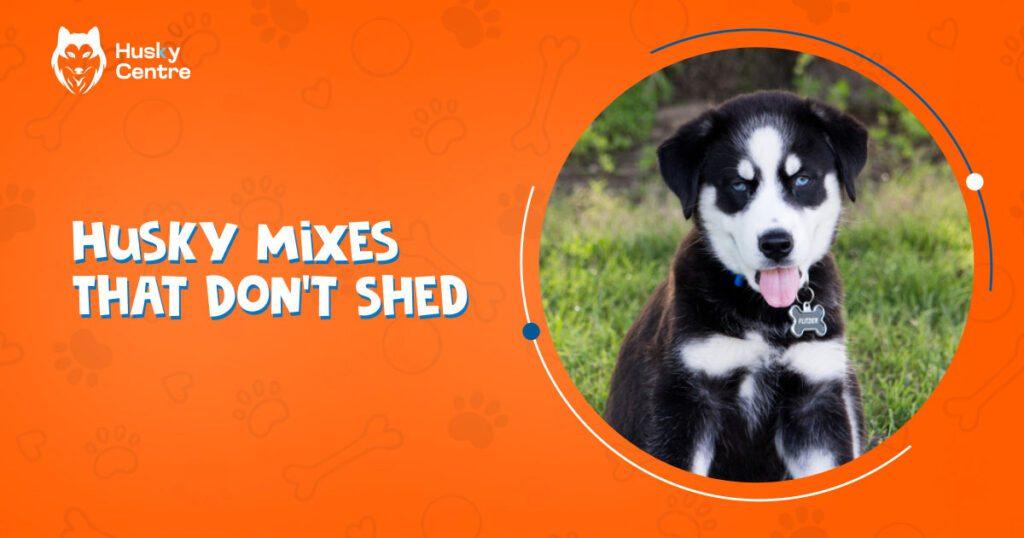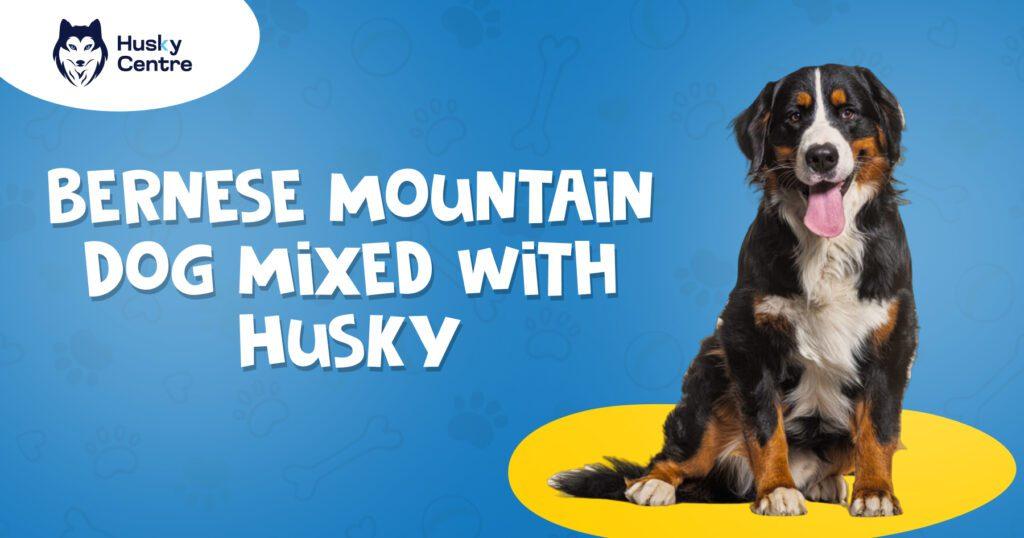No Husky mixes are entirely shed-free. Some mixes may shed less than purebred Huskies.
Huskies are known for their thick, double-layered coats, which typically result in significant shedding. While no Husky mix is completely shed-free, some crossbreeds may shed less, making them more manageable for those seeking a lower-shedding dog. Breeds like the Poodle, known for its minimal shedding, when mixed with a Husky, can potentially produce a dog with reduced shedding.
This can be an appealing option for those who love the Husky’s characteristics but prefer a pet with less hair maintenance. It’s essential to research and understand the grooming needs of any Husky mix to ensure it fits your lifestyle.
Common Husky Mixes That Don’t Shed
Huskies are known for their thick fur and frequent shedding. But there are Husky mixes that don’t shed as much. These mixes combine the Husky’s beauty with other breeds’ low-shedding traits. Let’s explore some common Husky mixes that don’t shed as much.
Huskador (husky + Labrador Retriever)
The Huskador is a mix between a Husky and a Labrador Retriever. This breed is popular due to its friendly and loyal nature. They typically have short to medium fur, which sheds less than a pure Husky’s coat.
Key characteristics:
- Loyal and friendly
- Medium energy level
- Short to medium-length coat
Huskadors are excellent family pets. They get along well with children and other pets. Their grooming needs are moderate. Regular brushing helps keep their coat in good condition and reduces shedding. Due to their Labrador genes, they are also very trainable and eager to please.
| Trait | Description |
| Size | Medium to large |
| Life Span | 10-15 years |
| Grooming Needs | Moderate |
Pomsky (husky + Pomeranian)
The Pomsky is a delightful mix of a Husky and a Pomeranian. Known for their small size and fluffy coat, Pomskies are both cute and charismatic. They shed less than pure Huskies due to their Pomeranian genes.
Key characteristics:
- Small and adorable
- Playful and energetic
- Fluffy coat
Pomskies are perfect for apartment living. They do well in smaller spaces and are great companions. Regular grooming is essential to keep their coat healthy. They are intelligent and can be trained easily with positive reinforcement.
| Trait | Description |
| Size | Small |
| Life Span | 12-15 years |
| Grooming Needs | High |
Goberian (husky + Golden Retriever)
The Goberian is a mix of a Husky and a Golden Retriever. This breed is known for its friendly and outgoing nature. They typically have a medium-length coat, which sheds less than a pure Husky’s coat.
Key characteristics:
- Friendly and outgoing
- Medium to high energy level
- Medium-length coat
Goberians make great family pets. They are good with children and other pets. They require regular brushing to keep their coat in good condition and reduce shedding. They are intelligent and easy to train, making them ideal for active families.
| Trait | Description |
| Size | Medium to large |
| Life Span | 10-14 years |
| Grooming Needs | Moderate |
Ausky (husky + Australian Shepherd)
The Ausky is a mix between a Husky and an Australian Shepherd. This breed is known for its intelligence and agility. They usually have a short to medium-length coat, which sheds less than a pure Husky’s coat.
Key characteristics:
- Intelligent and agile
- High energy level
- Short to medium-length coat
Auskies are ideal for active individuals or families. They need regular exercise and mental stimulation. Their grooming needs are moderate. Regular brushing helps keep their coat in good condition and reduces shedding. They are quick learners and excel in obedience training.
| Trait | Description |
| Size | Medium |
| Life Span | 12-15 years |
| Grooming Needs | Moderate |
Boxsky (husky + Boxer)
The Boxsky is a mix of a Husky and a Boxer. This breed is known for its playful and energetic nature. They typically have a short coat, which sheds less than a pure Husky’s coat.
Key characteristics:
- Playful and energetic
- Medium to high energy level
- Short coat
Boxskies are great for active families. They enjoy outdoor activities and need regular exercise. Their grooming needs are low. Regular brushing helps keep their coat in good condition and reduces shedding. They are also intelligent and easy to train, making them great companions.
| Trait | Description |
| Size | Medium |
| Life Span | 10-14 years |
| Grooming Needs | Low |
Understanding Coat Types
Husky mixes are popular for their stunning looks and friendly nature. Many dog lovers worry about shedding, especially with Husky breeds. Understanding coat types is key to finding a Husky mix that doesn’t shed excessively. This knowledge helps in choosing the right breed for your home and lifestyle.
Factors Influencing Shedding
Several factors influence a dog’s shedding patterns. These include breed, coat type, health, and environment.
- Breed: Different breeds shed differently. Some shed year-round, while others shed seasonally.
- Coat Type: Double-coated dogs shed more than single-coated ones. The texture and length of the coat also play a role.
- Health: Poor health or nutritional deficiencies can increase shedding. Regular vet check-ups help maintain a healthy coat.
- Environment: Changes in temperature and seasons affect shedding. Indoor dogs may shed less due to controlled climates.
Understanding these factors helps in managing and reducing shedding. Regular grooming and a healthy diet are essential for a well-maintained coat.
Difference Between Double-coated And Single-coated Breeds
Coat type is crucial in determining shedding levels. Here’s a comparison between double-coated and single-coated breeds:
| Feature | Double-Coated Breeds | Single-Coated Breeds |
| Coat Layers | Two layers: an undercoat and a topcoat | One layer: just a topcoat |
| Shedding | Heavy shedding, especially during seasonal changes | Minimal shedding year-round |
| Maintenance | Requires more grooming and care | Easier to maintain with less grooming |
Double-coated breeds have an undercoat that sheds heavily during spring and fall. This coat provides insulation and protection.
Single-coated breeds shed less. They lack an undercoat, making them easier to groom and maintain.
Choosing a single-coated Husky mix reduces shedding and simplifies grooming. Understanding coat types helps in making an informed decision.
Care And Maintenance
Finding a Husky mix that doesn’t shed can be a game-changer for dog lovers with allergies or those wanting a cleaner home. These low-shedding breeds combine the beauty of a Husky with less fur maintenance. Proper care and maintenance ensure these dogs stay healthy and comfortable. This section covers grooming, shedding tips, and bathing techniques to keep your low-shedding Husky mix in top shape.
Grooming Requirements For Low-shedding Husky Mixes
Low-shedding Husky mixes need regular grooming to maintain their coat and skin health. While they shed less, they still require attention:
- Brushing: Brush your dog at least twice a week to remove loose fur and prevent matting.
- Trimming: Regularly trim fur around the ears, paws, and tail to avoid tangles.
- Ear Cleaning: Clean ears weekly to prevent infections.
- Nail Clipping: Trim nails every month to prevent overgrowth and discomfort.
Here’s a quick reference table for grooming frequency:
| Grooming Task | Frequency |
| Brushing | Twice a week |
| Trimming | Monthly |
| Ear Cleaning | Weekly |
| Nail Clipping | Monthly |
Tips For Minimizing Shedding
While low-shedding Husky mixes shed less, some shedding is natural. Follow these tips to minimize it:
- Diet: Feed your dog a high-quality diet rich in omega-3 and omega-6 fatty acids for a healthy coat.
- Hydration: Ensure your dog drinks plenty of water to keep their skin hydrated.
- Regular Exercise: Exercise helps reduce stress, which can cause shedding.
- Seasonal Grooming: Increase grooming frequency during seasonal changes when shedding might increase.
Consider using a de-shedding tool for more thorough grooming. These tools reach deeper into the coat to remove loose fur before it ends up on your furniture.
Bathing And Brushing Techniques
Proper bathing and brushing techniques are crucial for maintaining a low-shedding Husky mix’s coat:
Bathing:
- Frequency: Bathe your dog every 6-8 weeks, depending on their activity level and coat condition.
- Shampoo: Use a mild, hypoallergenic dog shampoo to avoid skin irritation.
- Rinsing: Rinse thoroughly to ensure no shampoo residue remains, which can cause itching.
Brushing:
- Tools: Use a slicker brush or a de-shedding tool for effective brushing.
- Technique: Brush in the direction of hair growth to avoid causing discomfort.
- Frequency: Brush after every bath and between baths at least twice a week.
Regular grooming, proper diet, and consistent bathing and brushing keep your low-shedding Husky mix looking great and feeling comfortable. This routine also helps build a stronger bond with your pet.
Temperament And Behavior
Husky mixes that don’t shed are a popular choice for dog lovers. Their temperament and behavior make them great companions. They offer a unique blend of traits from both the Husky and other breeds. Understanding their behavior helps in providing the best care.
Typical Traits Of Husky Mixes
Husky mixes are known for their friendly and outgoing nature. They are social dogs that love being around people. Here are some typical traits you might notice:
- Intelligent: These dogs are smart and quick learners.
- Energetic: They have a lot of energy and enjoy physical activities.
- Playful: They love to play games and have fun.
- Loyal: They form strong bonds with their families.
Though each Husky mix is unique, many share these common traits. Their mix of intelligence and energy makes them engaging companions. They thrive in active households where they get plenty of attention and exercise.
Socialization And Training Needs
Husky mixes benefit from early socialization and training. This helps them develop into well-behaved dogs. Start socializing your Husky mix puppy as soon as possible.
Introduce them to different people, places, and experiences. This exposure helps them become more confident and less fearful. Here are some tips for training and socialization:
- Positive Reinforcement: Use treats and praise to reward good behavior.
- Consistency: Be consistent with commands and rules.
- Social Opportunities: Arrange playdates with other dogs.
- Obedience Classes: Consider enrolling in obedience classes for structured training.
Training requires patience and dedication. But, with the right approach, your Husky mix can become a well-mannered member of the family.
Exercise And Mental Stimulation Requirements
Husky mixes need plenty of exercise and mental stimulation. This keeps them healthy and happy. Without enough activity, they can become bored and destructive. Here are some ways to meet their needs:
- Daily Walks: Aim for at least two walks per day.
- Playtime: Engage in fetch, tug-of-war, or other games.
- Training Sessions: Incorporate training into their routine.
- Interactive Toys: Provide toys that challenge their minds.
Husky mixes enjoy activities that challenge them both physically and mentally. Consider agility training or puzzle toys to keep them engaged. Regular exercise helps prevent behavioral issues and promotes a positive temperament.
Health Considerations
Husky mixes that don’t shed are a popular choice for families. These mixes combine the best traits of Huskies with low-shedding breeds, resulting in a pet that’s both beautiful and easier to maintain. Understanding their health considerations is crucial for ensuring these dogs live long, happy lives.
Common Health Issues In Husky Mixes
Husky mixes are generally healthy, but they can inherit certain health issues. It’s important to be aware of these potential problems:
- Hip Dysplasia: This genetic condition affects the hip joints, causing pain and mobility issues.
- Eye Conditions: Huskies are prone to cataracts and progressive retinal atrophy, which can lead to blindness.
- Skin Allergies: Some Husky mixes may develop allergies that cause itching and discomfort.
Here’s a table summarizing these common issues:
| Health Issue | Symptoms | Prevention/Treatment |
| Hip Dysplasia | Limping, difficulty standing | Regular exercise, weight management, surgery in severe cases |
| Eye Conditions | Cloudy eyes, vision loss | Regular eye exams, possible surgery |
| Skin Allergies | Itching, redness, hair loss | Hypoallergenic diet, medicated shampoos, vet-prescribed treatments |
Preventative Care And Regular Vet Check-ups
Preventative care is key to maintaining the health of your Husky mix. Regular vet check-ups help catch potential health issues early. Consider these steps:
- Annual Vet Visits: Schedule yearly check-ups to monitor overall health.
- Vaccinations: Keep up with vaccinations to prevent diseases.
- Dental Care: Brush your dog’s teeth regularly to avoid dental issues.
- Parasite Control: Use flea, tick, and heartworm preventatives.
During vet visits, discuss these important tests:
- Blood Tests: Check for underlying conditions.
- Eye Exams: Detect and treat eye diseases early.
- Joint Assessments: Identify signs of hip dysplasia.
Regular grooming also plays a role in preventative care. Brush your dog’s coat to check for skin issues. Bathing with hypoallergenic shampoos can keep their skin healthy.
Nutritional Needs And Diet Recommendations
Proper nutrition is vital for your Husky mix’s health. A balanced diet supports their energy levels and overall well-being.
Diet Recommendations:
- High-Quality Protein: Choose dog food with meat as the first ingredient.
- Healthy Fats: Ensure the diet includes omega-3 and omega-6 fatty acids for skin and coat health.
- Vitamins and Minerals: Look for food fortified with essential nutrients.
Feeding guidelines based on weight:
| Weight | Daily Food Amount |
| 20-30 lbs | 1.5 to 2 cups |
| 30-50 lbs | 2 to 3 cups |
| 50-70 lbs | 3 to 4 cups |
Ensure fresh water is always available. Consult your vet to tailor the diet to your dog’s specific needs. Avoid overfeeding to prevent obesity, which can exacerbate health issues.
Living Environment
Husky mixes that don’t shed offer a unique blend of the Husky’s charm without the hassle of constant fur. These low-shedding dogs are ideal for families or individuals who love the Husky’s look but need a more manageable pet. The right living environment is crucial for their happiness and health.
Suitable Living Conditions For Low-shedding Husky Mixes
Low-shedding Husky mixes thrive in a variety of living conditions. These dogs are adaptable and can live in both apartments and houses. However, certain conditions make them happier and healthier:
- Climate: Husky mixes prefer cooler climates. They can adapt to warmer areas but need proper cooling measures like air conditioning.
- Indoor Space: A spacious indoor area is beneficial. They need room to move and play even inside the house.
- Outdoor Access: Access to a secure yard is a plus. It allows them to expend energy and explore safely.
- Quiet Environment: These dogs do well in quieter neighborhoods. Too much noise can stress them out.
Space Requirements And Exercise Needs
Husky mixes have specific space and exercise needs. Meeting these needs ensures they stay healthy and happy:
- Indoor Space: They need ample space indoors to move around. Small apartments can work if they get enough outdoor exercise.
- Outdoor Space: A yard is ideal. If you don’t have one, ensure frequent walks and trips to the park.
Exercise is crucial for these active dogs. They require:
- Daily Walks: Aim for at least 1 hour of walking every day.
- Playtime: Interactive games like fetch or tug-of-war keep them engaged.
- Mental Stimulation: Puzzle toys and training sessions help stimulate their minds.
A balance of physical and mental exercise keeps them well-behaved and happy.
Compatibility With Families And Other Pets
Low-shedding Husky mixes are known for their friendly nature. They typically get along well with families and other pets:
- With Families: They are loyal and protective. These dogs form strong bonds with family members.
- With Kids: They are generally patient and playful. Supervise interactions with young children to ensure safety for both.
- With Other Pets: They can coexist with other pets. Proper socialization from a young age is key.
Here’s a quick compatibility table:
| Compatibility | Rating |
| Families | ★★★★★ |
| Kids | ★★★★☆ |
| Other Pets | ★★★★☆ |
With the right environment and care, low-shedding Husky mixes become cherished family members. They bring joy and companionship to any household.
Finding A Low-shedding Husky Mix
Huskies are known for their striking appearance and spirited energy, but they often come with a lot of shedding. If you love the look and personality of Huskies but want to avoid the shedding, consider a Husky mix that doesn’t shed. These mixes combine the best of the Husky breed with other low-shedding breeds to create a pet that’s both beautiful and easier to maintain.
Adoption From Shelters And Rescues
Adopting a low-shedding Husky mix from shelters or rescues can be a rewarding experience. Many shelters have a variety of mixed-breed dogs, some of which may have Husky lineage. You might find the perfect low-shedding companion.
Advantages of adopting from shelters:
- Lower cost: Adoption fees are generally lower than buying from breeders.
- Saving a life: You provide a home to a dog in need.
- Behavioral insights: Shelter staff often know the temperament of the dogs.
To increase your chances of finding a low-shedding Husky mix, visit multiple shelters and speak with staff about your preferences. Ask about the dog’s history and any information on its breed mix. Many rescues also provide foster-to-adopt programs, allowing you to see how the dog fits into your home before committing.
Working With Reputable Breeders
If you prefer getting a Husky mix from a breeder, make sure they are reputable. Reputable breeders prioritize the health and well-being of their dogs.
Characteristics of reputable breeders:
- Health guarantees: Provide health clearances for parent dogs.
- Transparency: Open about the breed mix and lineage.
- Socialization: Puppies are raised in a home environment.
Questions to ask breeders:
- What breeds are in the mix?
- Can I see the parents’ health certificates?
- What is your breeding philosophy?
- What kind of socialization do the puppies receive?
A table of reputable breeder characteristics: CharacteristicImportanceHealth guaranteesEnsures a healthy puppyTransparencyTrustworthy breeding practicesSocializationWell-adjusted puppies
Important Questions To Ask Before Adoption
Before adopting a low-shedding Husky mix, ask important questions to ensure a good match. Knowing the right questions can help you make an informed decision.
Key questions to ask:
- What is the dog’s energy level?
- Does the dog have any health issues?
- How does the dog behave around children and other pets?
- What type of grooming does the dog require?
Additional questions:
- What is the dog’s diet?
- Is the dog house-trained?
- What vaccinations has the dog received?
- Does the dog have any behavioral issues?
By asking these questions, you ensure the dog’s needs align with your lifestyle. This helps create a happy and harmonious home for both you and your new furry friend.
Frequently Asked Questions
What Husky Breeds Don T Shed A Lot?
Siberian Huskies and Alaskan Malamutes are husky breeds that don’t shed much. Regular grooming can help manage shedding.
Do All Husky Mixes Shed?
Yes, most husky mixes shed. They typically have thick double coats that shed year-round, especially during shedding seasons. Regular grooming helps manage shedding.
What Is The Best Mix With Husky?
The best mix with a Husky is often a Labrador. They combine the Husky’s energy with the Labrador’s friendliness, creating a balanced, loving pet.
What Breed Of Husky Stays Small?
The Alaskan Klee Kai is a small breed of husky. They resemble Siberian Huskies but stay much smaller in size.
Conclusion
Choosing a husky mix that doesn’t shed can simplify pet ownership. These breeds offer the joy of a husky without the mess. Enjoy a clean home and a loving companion. Each husky mix has unique traits, so find the best fit for your lifestyle.
Happy pet parenting!


Meet Jarred, the heart and soul behind HukyCentre. With a deep affection for furry friends, he pours his passion into every word he writes. His genuine love for dogs shines through in his engaging and informative content. As a dedicated dog enthusiast, Jarred’s goal is to share valuable insights and tips that resonate with fellow dog lovers. Join Jarred on the journey as he celebrates the joy and companionship that dogs bring into our lives.



